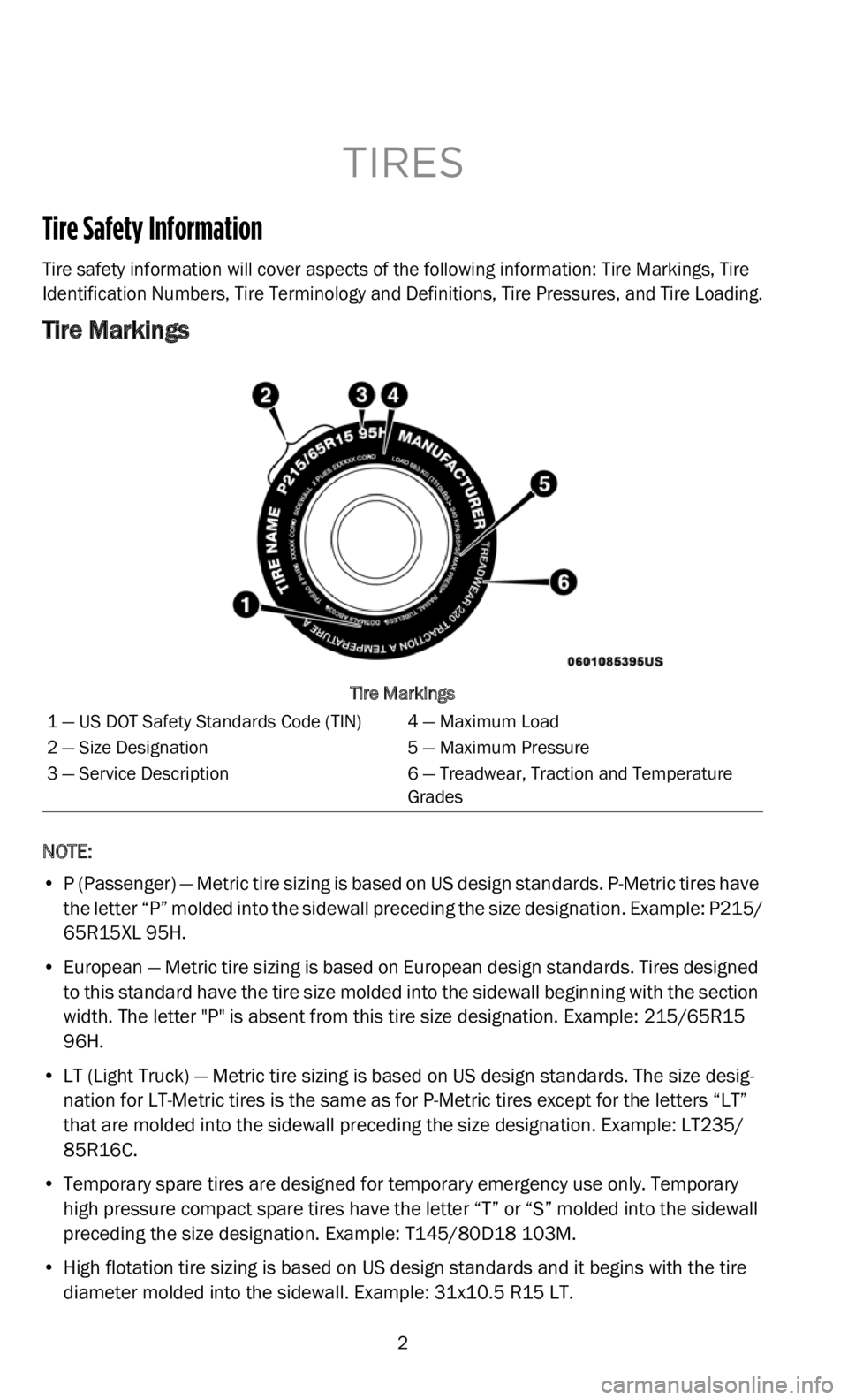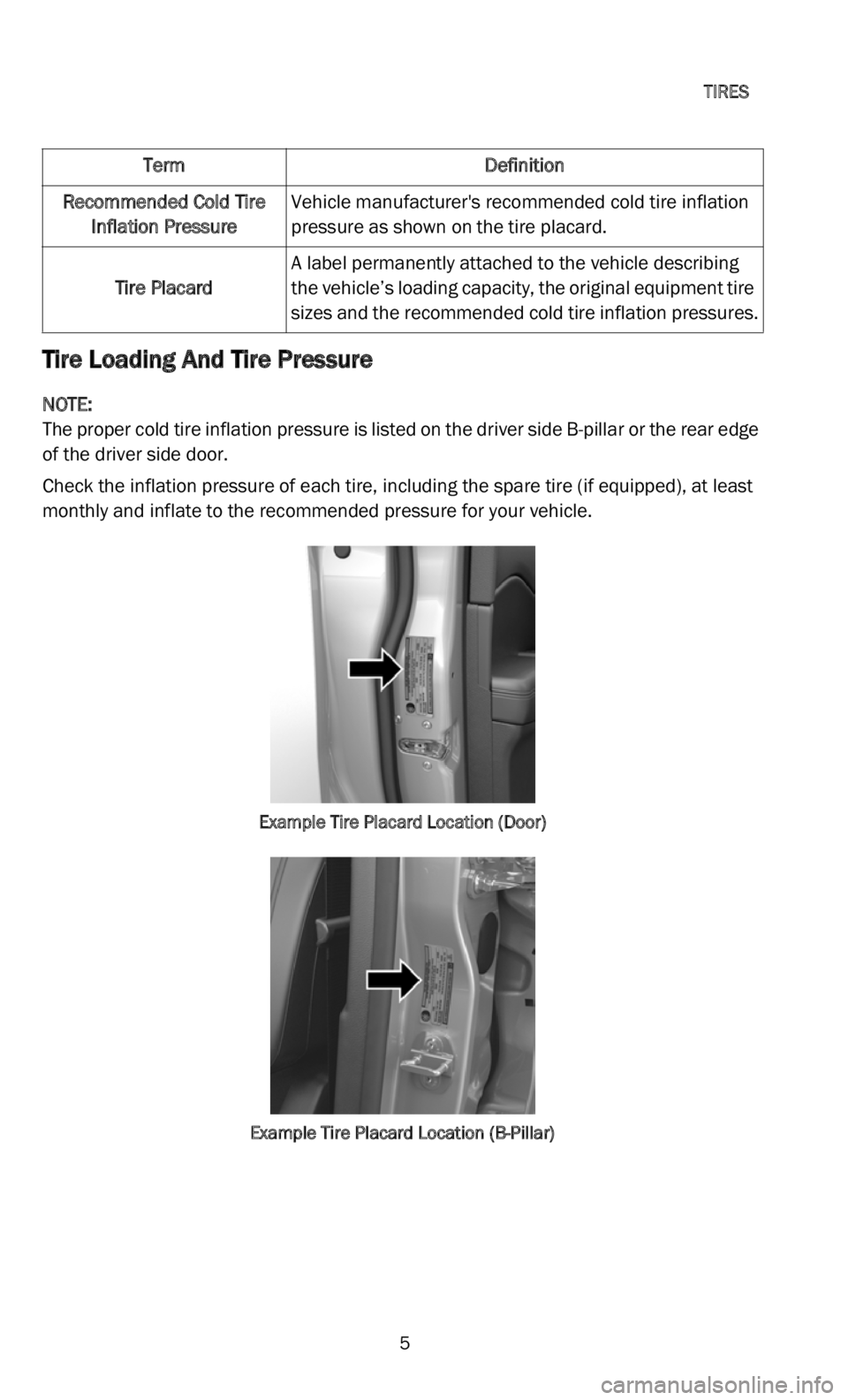tire size DODGE DURANGO 2022 Vehicle Warranty
[x] Cancel search | Manufacturer: DODGE, Model Year: 2022, Model line: DURANGO, Model: DODGE DURANGO 2022Pages: 200, PDF Size: 6.72 MB
Page 3 of 200

2
TIRES
Tire Safety Information
Tire safety information will cover aspects of the following information: Tire Markings, Tire
Identification Numbers, Tire Terminology and Definitions, Tire Pressures, and Tire Loading.
Tire Markings
Tire Markings
NOTE:
• P (Passenger) — Metric tire sizing is based on US design standards. P-Metric tires haveth
e letter “P” molded into the sidewall preceding the size designation. Example: P215/
65R15XL 95H.
• European — Metric tire sizing is based on European design standards. Tires designed to
this standard have the tire size molded into the sidewall beginning with the section
width. The letter "P" is absent from this tire size designation. Example: 215/65R15
96H.
• LT (Light Truck) — Metric tire sizing is based on US design standards. The size desig -
n a
tion for LT-Metric tires is the same as for P-Metric tires except for the letters “LT”
th a
t are molded into the sidewall preceding the size designation. Example: LT235/
85R16C.
• Temporary spare tires are designed for temporary emergency use only. Temporary hi
gh pressure compact spare tires have the letter “T” or “S” molded into the sidewall
preceding the size designation. Example: T145/80D18 103M.
• High flotation tire sizing is based on US design standards and it begins with the tire di
ameter molded into the sidewall. Example: 31x10.5 R15 LT.
1 — US DOT Safety Standards Code (TIN) 4 — Maximum Load
2 — Size Designation 5 — Maximum Pressure
3 — Service Description 6 — Treadwear, Traction and Temperature
Gra
des
Page 4 of 200

TIRES
3
Tire Sizing Chart
EXAMPLE:
Example Size Designation: P215/65R15XL 95H, 215/65R15 96H, LT235/85R16C,
T1 4
5/80D18 103M, 31x10.5 R15 LT
P = Passenger car tire size based on US design standards, or
"....blank...." =
Passenger car tire based on European design standards, or
LT = Light Truck tire based on US design standards, or
T
or S = Temporary spare tire or
3 1 =
Overall diameter in inches (in)
2 1
5, 235, 145 =
Section width in millimeters (mm)
65, 85, 80 = Aspect ratio in percent (%)
• Ra
tio of section height to section width of tire, or 10
.5 = Section width in inches (in)
R = Construction code
• "R" means radial construction, or
• "D
" means diagonal or bias construction
1 5
, 16, 18 = Rim diameter in inches (in)
S e
rvice Description:
95 = Load Index
• A
numerical code associated with the maximum load a tire can carry
H
= Speed Symbol
• A symbol indicating the range of speeds at which a tire can carry a load corre -
s p
onding to its load index under certain operating conditions
• The maximum speed corresponding to the speed symbol should only be achieved un
der specified operating conditions (i.e., tire pressure, vehicle loading, road condi -
tions, and posted speed limits)
Load Identification:
Absence of the following load identification symbols on the sidewall of the tire
in d
icates a Standard Load (SL) tire:
• XL = Extra load (or reinforced) tire, or
• LL =
Light load tire or
• C, D, E, F, G =
Load range associated with the maximum load a tire can carry at a
specified pressure
Maximum Load –
Maximum load indicates the maximum load this tire is designed to
carry
Maximum Pressure –
Maximum pressure indicates the maximum permissible cold tire
inflation pressure for this tire
Page 5 of 200

TIRES
4
Tire Identification Number (TIN)
The TIN may be found on one or both sides of the tire; however, the date code may only
be on one side. Tires with white sidewalls will have the full TIN, including the date code,
located on the white sidewall side of the tire. Look for the TIN on the outboard side of
black sidewall tires as mounted on the vehicle. If the TIN is not found on the outboard
side, then you will find it on the inboard side of the tire.
Tire Terminology And Definitions
EXAMPLE:
DOT MA L9 ABCD 0301
DOT = Department of Transportation
• Th
is symbol certifies that the tire is in compliance with the US Department of Trans -
p o
rtation tire safety standards and is approved for highway use
MA = Code representing the tire manufacturing location (two digits)
L9
= Code representing the tire size (two digits)
ABCD = Code used by the tire manufacturer (one to four digits)
03 =
Number representing the week in which the tire was manufactured (two digits)
• 03 m
eans the 3rd week
01 = Number representing the year in which the tire was manufactured (two digits)
• 01 m
eans the year 2001
• Prior to July 2000, tire manufacturers were only required to have one number to
re
present the year in which the tire was manufactured. Example: 031 could repre -
sent the 3rd week of 1981 or 1991
Term Definition
B-pillar The vehicle B-pillar is the structural member of the body
l
o c
ated behind the front door.
Cold Tire Inflation Pressure Cold tire inflation pressure is defined as the tire pressure
af
t
er the vehicle has not been driven for at least three
hours, or driven less than 1 mile (1.6 km) after sitting for
a m
inimum of three hours. Inflation pressure is
measured in units of psi (pounds per square inch) or kPa
(kilopascals).
Maximum Inflation Pressure The maximum inflation pressure is the maximum
p
e
r
missible cold tire inflation pressure for this tire. The
maximum inflation pressure is molded into the sidewall.
Page 6 of 200

TIRES
5
Tire Loading And Tire Pressure
NOTE:
The proper cold tire inflation pressure is listed on the driver side B-pillar or the rear edge
of
the driver side door.
Check the inflation pressure of each tire, including the spare tire (if equipped), at least
mo n
thly and inflate to the recommended pressure for your vehicle.
Example Tire Placard Location (Door)
Example Tire Placard Location (B-Pillar)
Recommended Cold Tire Inflation Pressure Vehicle manufacturer's recommended cold tire inflation
pre
ssure as shown on the tire placard.
Tire Placard A label permanently attached to the vehicle describing
th
e
vehicle’s loading capacity, the original equipment tire
sizes and the recommended cold tire inflation pressures.
Term Definition
Page 7 of 200

TIRES
6
Tire And Loading Information Placard
Tire And Loading Information Placard
This placard tells you important information about the:
1. Number of people that can be carried in the vehicle.
2.
Total weight your vehicle can carry.
3 .
Tire size designed for your vehicle.
4 .
Cold tire inflation pressures for the front, rear, and spare tires.
Loading
The vehicle maximum load on the tire must not exceed the load carrying capacity of the
tire on your vehicle. You will not exceed the tire's load carrying capacity if you adhere to
the loading conditions, tire size, and cold tire inflation pressures specified on the Tire and
Loading Information placard in “Vehicle Loading” in the “Starting And Operating” section
of your Owner’s Manual.
NOTE:
Under a maximum loaded vehicle condition, Gross Axle Weight Ratings (GAWRs) for the
f r o
nt and rear axles must not be exceeded. For further information on GAWRs, vehicle
loading, and trailer towing, refer to “Vehicle Loading” in the “Starting And Operating”
section of your Owner’s Manual.
To determine the maximum loading conditions of your vehicle, locate the statement “The
co m
bined weight of occupants and cargo should never exceed XXX kg or XXX lb” on the
Tire and Loading Information placard. The combined weight of occupants, cargo/luggage
and trailer tongue weight (if applicable) should never exceed the weight referenced here.
Page 8 of 200

TIRES
7
Steps For Determining Correct Load Limit—
(1) Locate the statement “The combined weight of occupants and cargo should never
ex c
eed XXX kg or XXX lb” on your vehicle's placard.
(2) Determine the combined weight of the driver and passengers that will be riding in
yo u
r vehicle.
(3) Subtract the combined weight of the driver and passengers from XXX kg or
XXX lb.
(4) The resulting figure equals the available amount of cargo and luggage load capacity.
Fo r
example, if “XXX” amount equals 1,400 lb and there will be five 150 lb passengers
in your vehicle, the amount of available cargo and luggage load capacity is 650 lb
(1,400-750 (5x150) = 650 lb).
(5) Determine the combined weight of luggage and cargo being loaded on the vehicle.
Th a
t weight may not exceed the available cargo and luggage load capacity calculated in
Step 4.
(6) If your vehicle will be towing a trailer, the load from your trailer will be transferred to
yo u
r vehicle. Consult this manual to determine how this reduces the available cargo and
luggage load capacity of your vehicle.
Metric Example For Load Limit
For example, as shown in step 4 above, if “XXX” amount equals 635 kg and there will be
fi v
e 68 kg passengers in your vehicle, the amount of available cargo and luggage load
capacity is 295 kg (635-340 (5x68) = 295 kg).
NOTE:
• If your vehicle will be towing a trailer, the load from your trailer will be transferred to yo
ur vehicle. The following table shows examples on how to calculate total load,
cargo/luggage, and towing capacities of your vehicle with varying seating configura -
tions and number and size of occupants. This table is for illustration purposes only and
ma y
not be accurate for the seating and load carrying capacity of your vehicle.
• For the following example, the combined weight of occupants and cargo should never ex
ceed 865 lb (392 kg).
Page 12 of 200

TIRES
11
Tire Pressures For High Speed Operation
FCA US LLC advocates driving at safe speeds and within posted speed limits. Where
speed limits or conditions are such that the vehicle can be driven at high speeds,
maintaining correct tire inflation pressure is very important. Increased tire pressure and
reduced vehicle loading may be required for high-speed vehicle operation. Refer to an
authorized tire dealer or original equipment vehicle dealer for recommended safe
operating speeds, loading and cold tire inflation pressures.
Radial Ply Tires
Tire Repair
If your tire becomes damaged, it may be repaired if it meets the following criteria:
• The tire has not been driven on when flat.
• Th
e damage is only on the tread section of your tire (sidewall damage is not repair -
a b
le).
• The puncture is no greater than a ¼ of an inch (6 m
m).
Consult an authorized tire dealer for tire repairs and additional information.
Damaged Run Flat tires, or Run Flat tires that have experienced a loss of pressure should
be
replaced immediately with another Run Flat tire of identical size and service
description (Load Index and Speed Symbol).
Run Flat Tires — If Equipped
Run Flat tires allow you the capability to drive 50 miles (80 km) at 50 mph (80 km/h)
aft
er a rapid loss of inflation pressure. This rapid loss of inflation is referred to as the Run
Flat mode. A Run Flat mode occurs when the tire inflation pressure is of/or below 14 psi
(96 kPa). Once a Run Flat tire reaches the Run Flat mode, it has limited driving
capabilities and needs to be replaced immediately. A Run Flat tire is not repairable.
It is not recommended to drive a vehicle loaded at full capacity or to tow a trailer while a
tir
e is in the Run Flat mode.
See the Tire Pressure Monitoring System (TPMS) section for more information.
WARNING!
High speed driving with your vehicle under maximum load is dangerous. The added
strain on your tires could cause them to fail. You could have a serious collision. Do not
drive a vehicle loaded to maximum capacity at continuous speeds above 75 mph
(1 2
0 km/h).
WARNING!
Combining radial ply tires with other types of tires on your vehicle will cause your
vehicle to handle poorly. The instability could cause a collision. Always use radial ply
tires in sets of four. Never combine them with other types of tires.
Page 14 of 200

TIRES
13
Life Of Tire
The service life of a tire is dependent upon varying factors including, but not limited to:
• D riving style.
•
Tire pressure - Improper cold tire inflation pressures can cause uneven wear patterns
t
o develop across the tire tread. These abnormal wear patterns will reduce tread life,
resulting in the need for earlier tire replacement.
• D istance driven.
•
Performance tires, tires with a speed rating of V or higher, and Summer tires typically
h
ave a reduced tread life. Rotation of these tires per the vehicle scheduled mainte -
nance is highly recommended.
Keep dismounted tires in a cool, dry place with as little exposure to light as possible.
P r
otect tires from contact with oil, grease, and gasoline.
Replacement Tires
The tires on your new vehicle provide a balance of many characteristics. They should be
inspected regularly for wear and correct cold tire inflation pressures. FCA US LLC strongly
recommends that you use tires equivalent to the originals in size, quality and
performance when replacement is needed. Refer to the paragraph on “Tread Wear
Indicators” in this section. Refer to the Tire and Loading Information placard or the
Vehicle Certification Label for the size designation of your tires. The Load Index and
Speed Symbol for your tires will be found on the original equipment tire sidewall.
See the Tire Sizing Chart example found in the “Tire Safety Information” section of this
ma
nual for more information relating to the Load Index and Speed Symbol of a tire.
It is recommended to replace the two front tires or two rear tires as a pair. Replacing just
o n
e tire can seriously affect your vehicle’s handling. If you ever replace a wheel, make
sure that the wheel’s specifications match those of the original wheels.
It is recommended you contact an authorized tire dealer or original equipment dealer with
a n
y questions you may have on tire specifications or capability. Failure to use equivalent
replacement tires may adversely affect the safety, handling, and ride of your vehicle.
WARNING!
Tires and the spare tire should be replaced after six years, regardless of the remaining
tread. Failure to follow this warning can result in sudden tire failure. You could lose
control and have a collision resulting in serious injury or death.
Page 15 of 200

TIRES
14
Tire Types
All Season Tires — If Equipped
All season tires provide traction for all seasons (Spring, Summer, Autumn, and Winter).
Traction levels may vary between different all season tires. All season tires can be
identified by the M+S, M&S, M/S or MS designation on the tire sidewall. Use all season
tires only in sets of four; failure to do so may adversely affect the safety and handling of
your vehicle.
Summer Or Three Season Tires — If Equipped
Summer tires provide traction in both wet and dry conditions, and are not intended to be
driven in snow or on ice. If your vehicle is equipped with summer tires, be aware these
tires are not designed for winter or cold driving conditions. Install winter tires on your
vehicle when ambient temperatures are less than 40°F (5°C) or if roads are covered
with ice or snow. For more information, contact an authorized dealer.
Summer tires do not contain the all season designation or mountain/snowflake symbol
on
the tire sidewall. Use summer tires only in sets of four; failure to do so may adversely
affect the safety and handling of your vehicle.
WARNING!
• Do not use a tire, wheel size, load rating, or speed rating other than that specified for your vehicle. Some combinations of unapproved tires and wheels may change
suspension dimensions and performance characteristics, resulting in changes to
steering, handling, and braking of your vehicle. This can cause unpredictable
handling and stress to steering and suspension components. You could lose control
and have a collision resulting in serious injury or death. Use only the tire and wheel
sizes with load ratings approved for your vehicle.
• Never use a tire with a smaller load index or capacity, other than what was originally eq
uipped on your vehicle. Using a tire with a smaller load index could result in tire
overloading and failure. You could lose control and have a collision.
• Failure to equip your vehicle with tires having adequate speed capability can result in
sudden tire failure and loss of vehicle control.
CAUTION!
Replacing original tires with tires of a different size may result in false speedometer
and odometer readings.
WARNING!
Do not use Summer tires in snow/ice conditions. You could lose vehicle control,
resulting in severe injury or death. Driving too fast for conditions also creates the
possibility of loss of vehicle control.
Page 16 of 200

TIRES
15
Snow Tires
Some areas of the country require the use of snow tires during the winter. Snow tires can
be identified by a “mountain/snowflake” symbol on the tire sidewall. If you need snow tires, select tires equivalent in size and type to the original
equipment tires. Use snow tires only in sets of four; failure to do so may
ad
versely affect the safety and handling of your vehicle.
Snow tires generally have lower speed ratings than what was originally equipped with
y o
ur vehicle and should not be operated at sustained speeds over 75 mph (120 km/h).
F o
r speeds above 75 mph (120 km/h) refer to original equipment or an authorized tire
d e
aler for recommended safe operating speeds, loading and cold tire inflation
pressures.
While studded tires improve performance on ice, skid and traction capability on wet or
d r
y surfaces may be poorer than that of non-studded tires. Some states prohibit studded
tires; therefore, local laws should be checked before using these tire types.
Spare Tires — If Equipped
Spare Tire Matching Original Equipped Tire And Wheel —
If Equipped
Your vehicle may be equipped with a spare tire and wheel equivalent in look and function
to the original equipment tire and wheel found on the front or rear axle of your vehicle.
This spare tire may be used in the tire rotation for your vehicle. If your vehicle has this
option, refer to an authorized tire dealer for the recommended tire rotation pattern.
Compact Spare Tire — If Equipped
The compact spare is for temporary emergency use only. You can identify if your vehicle
is equipped with a compact spare by looking at the spare tire description on the Tire and
Loading Information Placard located on the driver side door opening or on the sidewall
of the tire. Compact spare tire descriptions begin with the letter “T” or “S” preceding the
size designation. Example: T145/80D18 103M.
T, S = Temporary Spare Tire
Since this tire has limited tread life, the original equipment tire should be repaired (or
r e
placed) and reinstalled on your vehicle at the first opportunity.
Do not install a wheel cover or attempt to mount a conventional tire on the compact
s p
are wheel, since the wheel is designed specifically for the compact spare tire. Do not
install more than one compact spare tire and wheel on the vehicle at any given time.
CAUTION!
Because of the reduced ground clearance, do not take your vehicle through an
automatic car wash with a compact or limited use temporary spare installed. Damage
to the vehicle may result.